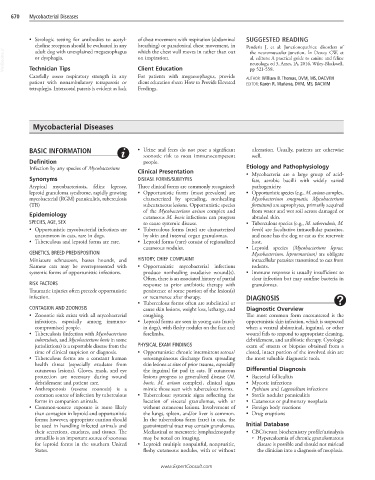Page 1325 - Cote clinical veterinary advisor dogs and cats 4th
P. 1325
670 Mycobacterial Diseases
• Serologic testing for antibodies to acetyl- of chest movement with respiration (abdominal SUGGESTED READING
choline receptors should be evaluated in any breathing) or paradoxical chest movement, in Penderis J, et al: Junctionopathies: disorders of
VetBooks.ir Technician Tips on inspiration. al, editors: A practical guide to canine and feline
adult dog with unexplained megaesophagus
which the chest wall moves in rather than out
the neuromuscular junction. In Dewey CW, et
or dysphagia.
neurology, ed 3, Ames, IA, 2016, Wiley-Blackwell,
Client Education
pp 521-558.
Carefully assess respiratory strength in any For patients with megaesophagus, provide AUTHOR: William B. Thomas, DVM, MS, DACVIM
patient with nonambulatory tetraparesis or client education sheet: How to Provide Elevated EDITOR: Karen R. Muñana, DVM, MS, DACVIM
tetraplegia. Intercostal paresis is evident as lack Feedings.
Mycobacterial Diseases
BASIC INFORMATION • Urine and feces do not pose a significant ulceration. Usually, patients are otherwise
zoonotic risk to most immunocompetent well.
Definition people.
Infection by any species of Mycobacterium Etiology and Pathophysiology
Clinical Presentation • Mycobacteria are a large group of acid-
Synonyms DISEASE FORMS/SUBTYPES fast, aerobic bacilli with widely varied
Atypical mycobacteriosis, feline leprosy, Three clinical forms are commonly recognized: pathogenicity.
leproid granuloma syndrome, rapidly growing • Opportunistic forms (most prevalent) are • Opportunistic species (e.g., M. avium complex,
mycobacterial (RGM) panniculitis, tuberculosis characterized by spreading, nonhealing Mycobacterium smegmatis, Mycobacterium
(TB) subcutaneous lesions. Opportunistic species fortuitum) are saprophytes, primarily acquired
of the Mycobacterium avium complex and from water and wet soil across damaged or
Epidemiology cutaneous M. bovis infections can progress abraded skin.
SPECIES, AGE, SEX to cause systemic disease. • Tuberculous species (e.g., M. tuberculosis, M.
• Opportunistic mycobacterial infections are • Tuberculous forms (rare) are characterized bovis) are facultative intracellular parasites,
uncommon in cats, rare in dogs. by skin and internal organ granulomas. and none has the dog or cat as the reservoir
• Tuberculous and leproid forms are rare. • Leproid forms (rare) consist of regionalized host.
cutaneous nodules. • Leproid species (Mycobacterium leprae,
GENETICS, BREED PREDISPOSITION Mycobacterium. lepraemurium) are obligate
Miniature schnauzers, basset hounds, and HISTORY, CHIEF COMPLAINT intracellular parasites transmitted to cats from
Siamese cats may be overrepresented with • Opportunistic mycobacterial infections rodents.
systemic forms of opportunistic infections. produce nonhealing exudative wound(s). • Immune response is usually insufficient to
Often, there is an associated history of partial clear infection but may confine bacteria in
RISK FACTORS response to prior antibiotic therapy with granulomas.
Traumatic injuries often precede opportunistic persistence of some portion of the lesion(s)
infection. or recurrence after therapy. DIAGNOSIS
• Tuberculous forms often are subclinical or
CONTAGION AND ZOONOSIS cause skin lesions, weight loss, lethargy, and Diagnostic Overview
• Zoonotic risk exists with all mycobacterial coughing. The most common form encountered is the
infections, especially among immuno- • Leproid forms are seen in young cats (rarely opportunistic skin infection, which is suspected
compromised people. in dogs), with fleshy nodules on the face and when a ventral abdominal, inguinal, or other
• Tuberculosis (infection with Mycobacterium forelimbs. wound fails to respond to appropriate cleaning,
tuberculosis, and Mycobacterium bovis in some debridement, and antibiotic therapy. Cytologic
jurisdictions) is a reportable disease from the PHYSICAL EXAM FINDINGS exam of smears or biopsies obtained from a
time of clinical suspicion or diagnosis. • Opportunistic: chronic intermittent serous/ closed, intact portion of the involved skin are
• Tuberculous forms are a constant human serosanguineous discharge from spreading the most valuable diagnostic tools.
health threat (especially exudates from skin lesions at sites of prior trauma, especially
cutaneous lesions). Gloves, mask, and eye the inguinal fat pad in cats. If cutaneous Differential Diagnosis
protection are necessary during wound lesions progress to generalized disease (M. • Bacterial folliculitis
debridement and patient care. bovis, M. avium complex), clinical signs • Mycotic infections
• Anthroponosis (reverse zoonosis) is a mimic those seen with tuberculous forms. • Pythium and Lagenidium infections
common source of infection by tuberculous • Tuberculous: systemic signs reflecting the • Sterile nodular panniculitis
forms in companion animals. location of visceral granulomas, with or • Cutaneous or pulmonary neoplasia
• Common-source exposure is more likely without cutaneous lesions. Involvement of • Foreign body reactions
than contagion in leproid and opportunistic the lungs, spleen, and/or liver is common. • Drug eruptions
forms; however, appropriate caution should In the tuberculous form (rare) in cats, the
be used in handling infected animals and gastrointestinal tract may contain granulomas. Initial Database
their secretions, exudates, and tissues. The Mediastinal or mesenteric lymphadenopathy • CBC/serum biochemistry profile/urinalysis
armadillo is an important source of zoonoses may be noted on imaging. ○ Hypercalcemia of chronic granulomatous
for leproid forms in the southern United • Leproid: multiple nonpainful, nonpruritic, disease is possible and should not mislead
States. fleshy cutaneous nodules, with or without the clinician into a diagnosis of neoplasia.
www.ExpertConsult.com

